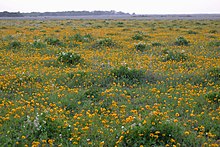en
names in breadcrumbs


As here circumscribed, Coreopsis tinctoria includes plants that others (without agreement among themselves) have treated as distinct species or infraspecific taxa: C. atkinsoniana (plants mostly 50–150+ cm, seldom branched from bases; cypselae 2.5–3 mm, "narrowly" winged; pappi 0.1–0.2 mm; mostly Idaho, Montana, Oregon, Washington), C. cardaminefolia (plants mostly 20–50 cm, seldom branched at bases; cypselae 2 mm, "narrowly to widely" winged; pappi 0 or 0.1–0.2 mm; mostly Arkansas, Kansas, Louisiana, Nebraska, Oklahoma, Texas), and C. tinctoria var. similis (plants mostly 10–30 cm, usually branched from bases; cypselae 2–3 mm, "widely" winged; pappi 0.2–1 mm; Texas and Mexico).
Plains coreopsis, garden tickseed,[2] golden tickseed, [3] or calliopsis, Coreopsis tinctoria, is an annual forb. The plant is common in Canada (from Quebec to British Columbia), northeast Mexico (Coahuila, Nuevo León, Tamaulipas), and much of the United States, especially the Great Plains and Southern states where it is often called "calliopsis."[4][5] The species is also widely cultivated and naturalized in China.[6]
It often grows in disturbed areas such as roadsides and cultivated fields.[7]

Growing quickly, Coreopsis tinctoria attains heights of 30–100 cm (12–40 in). Its leaves are pinnately-divided, glabrous and tend to thin at the top of the plant where numerous 25–40 mm (1–1+1⁄2 in) flower heads sit atop slender stems.[8]
Flower heads are brilliant yellow with maroon or brown disc florets of various sizes. Flowering typically occurs in mid-summer. The small, slender seeds germinate in fall (overwintering as a low rosette) or early spring.[8] Ray florets have notched tips. Its native habitats include prairie, plains, meadows, pastures, savannas, roadsides, and pond banks.[9] The Latin specific epithet tinctoria refers to its use in dyeing.[10]
The Zuni people traditionally use the blossoms of the tinctoria variety to make a mahogany red dye for yarn,[11] and, until the introduction of coffee by traders, to make a hot beverage.[12] Women also used an infusion of the whole plant of this variety, except for the root, if they desired a female child.[13]
Plains coreopsis is cultivated as an ornamental plant for gardens, and as a native plant for wildlife gardens and natural landscaping. It grows well in many types of soil, but seems to prefer sandy or well-drained loam soils.[14] Although somewhat drought-tolerant, naturally growing plants are usually found in areas with regular rainfall. Preferring full sun, it will also grow in partial shade.[15] Though plains coreopsis is often described as an annual some plants will behave more like biannuals growing larger and blooming more in their second year.[14]
Because of its easy growing habits and the bright, showy flowers of cultivars such as 'Roulette' (tiger stripes of gold on a deep mahogany ground), plains coreopsis is increasingly used for landscape beautification and in flower gardens.[15]
Plains coreopsis, garden tickseed, golden tickseed, or calliopsis, Coreopsis tinctoria, is an annual forb. The plant is common in Canada (from Quebec to British Columbia), northeast Mexico (Coahuila, Nuevo León, Tamaulipas), and much of the United States, especially the Great Plains and Southern states where it is often called "calliopsis." The species is also widely cultivated and naturalized in China.
It often grows in disturbed areas such as roadsides and cultivated fields.